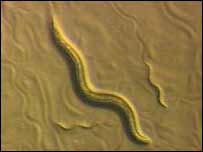
The C. elegans worm: The animal to have its genetic code laid bare
|
Hundreds of worms that were part of an experiment aboard the doomed space shuttle Columbia have been found alive in debris recovered from the crash site, US space agency (Nasa) officials say.
The Caenorhabditis elegans worms, which are about the size of a pin head, were in a four-kilogram (nine-pound) locker that was discovered in Texas several weeks ago.
However, the locker was not opened until this week, when experts were surprised to find that the worms, held in six canisters, each holding eight petri dishes, had survived.
Columbia broke up in the searing heat of re-entry into the Earth's atmosphere on 1 February killing all seven of its crew.
The shuttle had about 60 scientific experiments on board, with a number involving animals, including insects, spiders, fish, bees and silk worms.

Investigators are trying to piece the shuttle debris together
|
"To my knowledge, these are the only live experiments that have been located and identified," said Bruce Buckingham, a Nasa spokesman at the Kennedy Space Center.
Along with the worms the locker, which had been located in the shuttle mid-deck, was found to contain some moss from another experiment.
The C elegans worms have a life cycle of seven to 10 days, meaning that the ones found this week were likely to be four or five generations removed from the original space travellers.
Scientific milestone
The worms, which have two sexes - male and hermaphrodite - live in soil or among rotting plants and were part of an experiment testing a synthetic nutrient solution.
The experiment was put together by scientists at Nasa's Ames Research Center in California.
Despite it diminutive size, the C elegans was part of a massive step in scientific history in 1998 when it became the first multi-celled animal to have its genome completely sequenced.
This work paved the way for the decoding of the human genome, which was finished last month.
Preserved moss
The moss experiment, looking at the effects of micro-gravity on cell organisation, was also set up by Ames researchers and Dr Fred Sack at Ohio State University.
The moss, a Ceratodon species, was used to study how minimal gravity affects cell organisation.
The moss is dead, having been sprayed with a chemical that destroys protein fibre and then preserved in formaldehyde by Columbia astronaut Rick Husband during the flight.
Seven of the eight aluminium cans containing the moss were recovered.
"The cells were surprisingly well-preserved, but we're analysing how useful it's going to be," Dr Sack said.
"It's pretty astonishing to get the possibility of data after all that has happened. We never expected it. We expected a molten mass," he said.